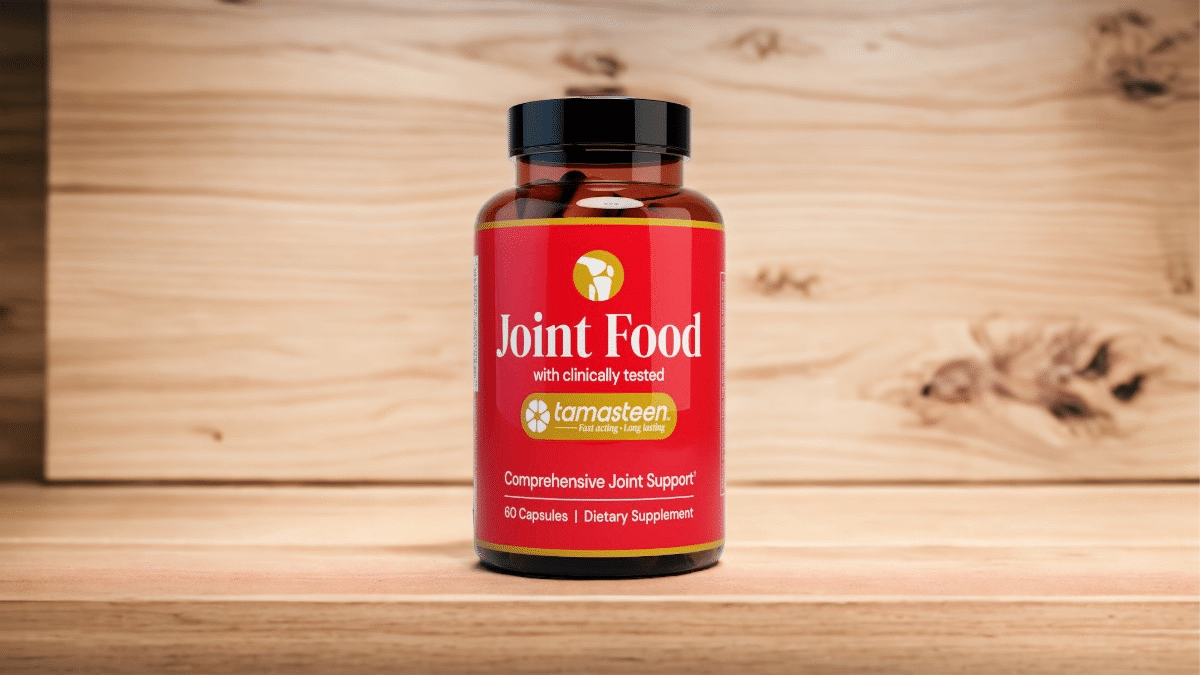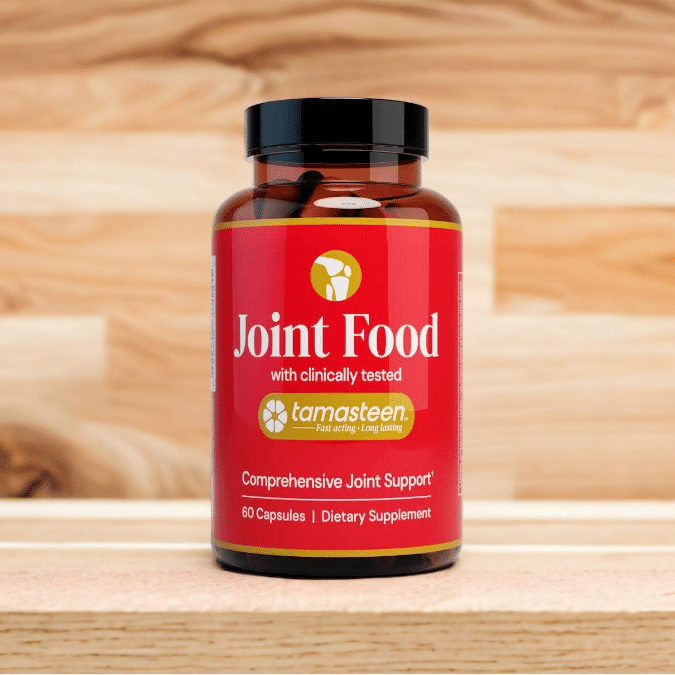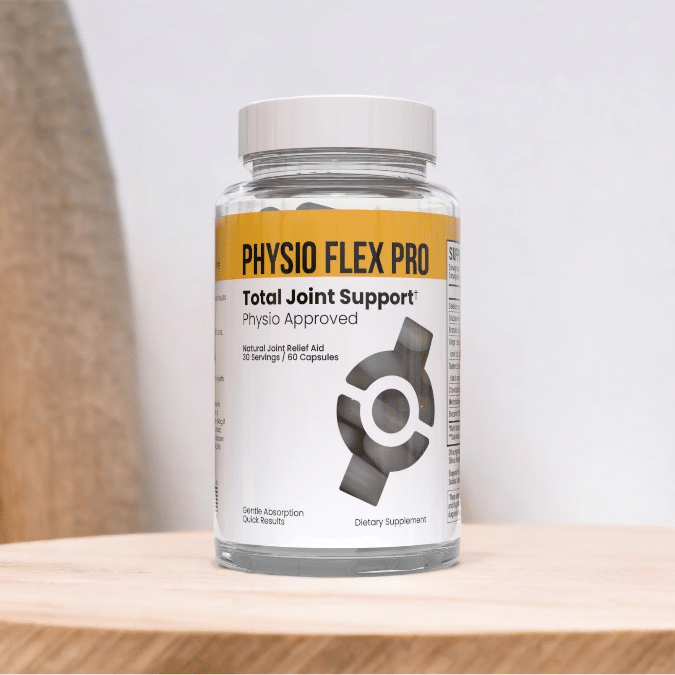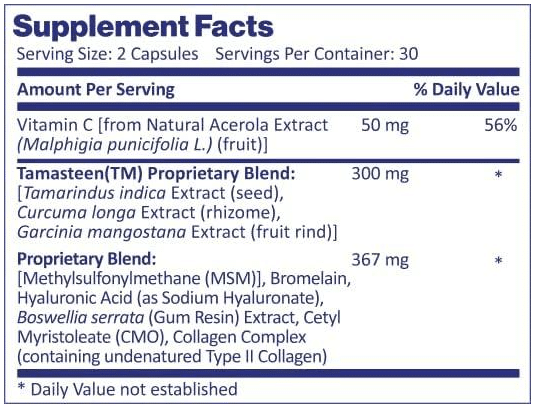Joint Food Review - Is It Right For You?

September 19, 2023
In this Joint Food review, we put this joint supplement from Nordic Healthy Living Inc to the test. Promising everything from quick relief to long-lasting comfort, this supplement is getting a lot of attention. It attributes its unique effectiveness to a special blend of ingredients called Tamasteen™, alongside a list of other familiar names in the joint-health game, like Vitamin C, MSM, and Hyaluronic Acid.
Now, the company has certainly gone the extra mile by including a range of ten different active ingredients. While each has its own merits—Vitamin C is an antioxidant, MSM is anti-inflammatory, and Hyaluronic Acid is known for its role in joint lubrication—the question remains: does this combination of ingredients actually deliver on its promise of next-level joint support?
We're going to dig deep into the science behind these ingredients, test the product for ourselves and find out if Joint Food really is a game changer, or if it's just another player in an already crowded field.

Overall Verdict
3.0 / 5 Stars

Introduction
Nordic Healthy Living Inc. is a supplement manufacturer with a single brand. Joint Food, their flagship product borrows heavily from the imagery and ideals of the Norwegian lifestyle and diet. While this U.S.-based company may bring to mind the fjords and fresh air, the actual core of the product lies in its scientific formulation designed to improve joint health.
At first glance, Joint Food's ingredient list looks intriguing. The supplement includes a variety of well-researched ingredients—Vitamin C for its antioxidant effects, Methysylfonylmethane (MSM) for anti-inflammatory benefits, and Hyaluronic Acid for joint lubrication, among others. However, eyebrows might start to rise at the mention of proprietary blends, notably Tamasteen™, which doesn't disclose the individual amounts of its components: Tamarindus Indica Extract, Curcuma Longa Extract, and Garcinia Mangostana Extract.
A key concern here is the potential for underdosed ingredients. Proprietary blends often obscure the exact dosages of each component, making it difficult to assess the effectiveness of the formula as a whole. Likewise, the presence of multiple active elements at relatively low doses—like Vitamin C at 50mg—raises questions about whether they're present in efficacious amounts.
In this review, we aim to understand the science behind Joint Food's formulation, scrutinizing the blend's potential benefits and drawbacks, and by testing the product ourselves, seek to answer the question: Does this supplement offer a substantive solution for joint discomfort, or is it merely another well-marketed contender in an already saturated market?
Benefits of Joint Food
Manufacturer's Claims
Joint Food claims to be a game-changer in joint health. It doesn't just say it'll ease your joint pain; it also promises to make your joints more flexible and give a nutritional boost to the cartilage and fluid that keep them moving smoothly. What's interesting is that it talks about giving both quick relief and lasting benefits, aiming for healthier, more flexible joints in the long run. The supplement says it's packed with ten key ingredients that are all about joint health, and it's particularly proud of its special blend called Tamasteen™, which it claims has been clinically proven to work. But as we all know, claims are one thing and reality is another. This review will dig into the science to see if Joint Food really lives up to all the hype.
Our Experience With Joint Food
After a thorough trial period of Joint Food, our experience, regrettably, failed to match the rosy picture painted by its marketing claims. Despite promises of rapid and sustained relief from joint discomfort, increased flexibility, and comprehensive nourishment for cartilage and synovial fluid, we observed negligible improvements, if any.
Let's start with the ingredient profile, which does present an intriguing combination of elements known for their role in joint health. Vitamin C, for example, serves as an antioxidant, essential for collagen synthesis and fighting inflammation (1). However, the 50mg dosage falls significantly below the recommended therapeutic doses, which can be upwards of 500mg for noticeable effects on joint health (2).
The real bone of contention, though, lies with the proprietary blends: Tamasteen™ and another unspecified blend including MSM, Bromelain, and Hyaluronic Acid, among others. The "secret sauce," Tamasteen™, boasts a concoction of Tamarindus Indica, Curcuma Longa, and Garcinia Mangostana extracts, all contained within a 300mg blend. Here's the rub: clinical studies suggest effective dosages for Curcuma Longa (turmeric) alone range from 500mg to 2,000mg (3, 4), which makes one question the effective concentration of each element in such a limited 300mg pool.
Similarly, the additional proprietary blend lists compounds like MSM and Hyaluronic Acid—both lauded for their potential in joint health. While the effective dosage of MSM is around 1,500mg (5), and for Hyaluronic Acid, it's about 200mg daily (6), the entire blend is only 367mg. It's a mathematical impossibility for these ingredients to exist in effective doses within this proprietary blend, thereby casting further skepticism on the supplement's overall efficacy (7, 8).
Our experiences reflect this. The lack of discernible benefits—whether it was waking up still feeling that familiar knee stiffness or failing to notice any enhanced mobility during a long walk—mirrored these questionable dosages and proprietary obscurities. Despite the allure of its marketing, boasting ten key ingredients and a 'clinically-proven secret,' the proof, as they say, is in the pudding—or in this case, the lack thereof.
The market for joint supplements is already saturated with various contenders (9), and while Joint Food attempts to differentiate itself by incorporating the imagery and philosophy of the Norwegian lifestyle, it appears to be more sizzle than steak (10). Therefore, based on our experience and the ingredient profile, Joint Food falls short of its lofty claims.
Research And Evidence
Joint Food by Nordic Healthy Living Inc. claims to be the "Next Generation Joint Support" solution, promising a gamut of benefits such as relief from joint discomfort, enhanced joint flexibility, and nourishment for joint cartilage and synovial fluid. The brand distinguishes itself with a proprietary blend they've named Tamasteen™, marketed as the "clinically-proven secret" inside their supplement. Yet, upon a thorough examination, it seems that the science behind the ingredient profile may not fully align with these ambitious marketing claims. Whilst the brand cites a clinical study in support of Tamasteen's role in supporting joint health, the study itself is conspicuous by its absence when cited and the validity of the results presented is impossible to verify.
Starting with Vitamin C, a 50mg dose is included in the supplement. While vitamin C is crucial for collagen synthesis, studies suggest that higher doses, in the range of 500-1000mg daily, are necessary for noticeable improvements in skin health, let alone joint health (11). The Tamasteen™ Proprietary Blend (300mg) includes Tamarindus Indica, Curcuma Longa, and Garcinia Mangostana. Curcuma Longa, or turmeric, has shown efficacy in relieving symptoms of joint arthritis, but generally at much higher dosages than what is likely included in a 300mg blend of multiple ingredients (12).
This brings us to another critical point: the issue of 'proprietary blends.' While a blend might contain potentially effective ingredients, the undisclosed individual dosages make it difficult to determine the blend's effectiveness. For example, MSM and Hyaluronic Acid are well-regarded for their role in joint health, yet are relegated to another undisclosed 'proprietary blend' of 367mg (13,14). In clinical trials, effective doses of MSM have been around 1.5g-6g, and Hyaluronic Acid around 80-200mg, suggesting that the available dosage in Joint Food would be insufficient (15,16).
The inclusion of Boswellia Serrata and Cetyl Myristoleate (CMO) further complicates the formula. While Boswellia has been studied for its anti-inflammatory properties, the effective dosages range upwards from 100mg (17). CMO, although less researched, usually requires doses around 300-600mg to be effective (18). Given these are all part of the same 367mg blend, it becomes mathematically impossible for each to be present in clinically effective doses.
Joint Food brings together an intriguing assortment of ingredients known for their roles in joint health, but the undisclosed proportions within the proprietary blends, coupled with seemingly low total dosages, raise questions about the product's ability to deliver on its comprehensive list of promises. While the idea of Tamasteen™ as a "clinically-proven secret" sounds appealing, the lack of dosage transparency inhibits any substantive verification of these claims (19,20).
Ingredients in Joint Food
- Vitamin C (50mg)
- Tamasteen Proprietary Blend (Tamarindus Indica Extract, Curcuma Longa Extract, Garcinia Mangostana Extract) (300mg)
- Proprietary Blend (Methysylfonylmethane (MSM), Bromelain, Hyaluronic Acid, Boswellia Serrata Extract, Cetyl Myristoleate (CMO), Collagen Complex (undenatured Type II Collagen) (367mg)
Does Joint Food's ingredient list and dosages align with the scientific evidence? Let's find out.
Starting with Vitamin C at 50mg, it's common knowledge that this antioxidant contributes to collagen synthesis, crucial for joint health. However, the Recommended Dietary Allowance (RDA) for vitamin C is around 65–90mg per day for adults, meaning the supplement falls short in providing a complete dose (21).
Joint Food features a proprietary blend called Tamasteen™, combining Tamarindus Indica, Curcuma Longa, and Garcinia Mangostana extracts at a total of 300mg. The term 'proprietary blend' is somewhat of a black box, as we're left in the dark regarding individual ingredient dosages. Curcuma Longa (turmeric) is of particular interest, with studies suggesting that doses of 400–600mg are needed for notable anti-inflammatory effects (22), well beyond the total amount included in the entire proprietary blend, meaning it's significantly underdosed.
Another blend in the formula includes Methysylfonylmethane (MSM), Bromelain, Hyaluronic Acid, Boswellia Serrata Extract, Cetyl Myristoleate (CMO), and Collagen Complex (undenatured Type II Collagen), summing up to 367mg. For MSM, the dosage commonly used in studies to treat osteoarthritis is about 1.5–3g daily (23). Hyaluronic acid is another joint superstar, but the effective dose for oral administration ranges between 80–200mg daily (24). This creates skepticism about the effectiveness of the proprietary blend, as it’s impossible for all these ingredients to be present at clinically meaningful amounts.
Proprietary blends aside, the other ingredients like Boswellia Serrata are well-recognized for their anti-inflammatory properties (25). However, the typical recommended dose for Boswellia Serrata in joint support is around 300–500mg per day, far beyond what could be contained in the 367mg proprietary blend (26).
Overall, while Joint Food employs ingredients known for their joint-supporting effects, the dosages do not align with clinical research guidelines. The use of proprietary blends further clouds the efficacy, casting doubt on whether the product can deliver on its marketing claims (27,28). The product's catchphrase may promise a 'next-generation' solution, but as of now, the science suggests we're not quite there yet.

Cons
Potential Side Effects of Joint Food
For the record, during our trial period, we didn't experience any adverse effects. However, it's worth mentioning that the rarity and mildness of side effects can't be entirely ruled out based on the ingredients within Joint Food's formulation.
Potential Side Effects and Corresponding Ingredients
- Digestive Issues: Ingredients like Bromelain and Boswellia Serrata Extract have been associated with gastrointestinal upset in some individuals (29,30).
- Allergic Reactions: MSM, present in the proprietary blend, has been rarely linked to skin allergies (31).
- Blood Thinning: Curcuma Longa (turmeric) can interact with anticoagulants, potentially increasing the risk of bleeding (32).
- Kidney Stones: The presence of Vitamin C at 50mg is generally safe, but in high doses, it can lead to kidney stone formation (33).
- Liver Concerns: Garcinia Mangostana has had limited reports indicating potential liver toxicity (34).
- Hypersensitivity: Collagen Complex could theoretically trigger an immune response, although this is rare (35).
- Interactions with Medications: Certain ingredients like Boswellia Serrata Extract and Curcuma Longa may interact with other medications, especially those for pain and inflammation (36).
- Hormonal Imbalance: Some sources suggest that Cetyl Myristoleate (CMO) could interfere with hormone levels, although this is speculative (37).
- Blood Sugar Fluctuations: Tamarindus Indica might lower blood sugar levels, posing concerns for diabetics (38).
- Low Blood Pressure: Hyaluronic Acid can sometimes cause blood pressure to drop, although this is not common (39).
The side effects associated with Joint Food's ingredients are usually rare and mild, according to existing scientific literature. Our own experience concurs with this assessment, as we encountered no issues during our evaluation period.
Best Alternative to Joint Food
If you're searching for a supplement to improve joint health and mobility, Joint Food may not be your best bet. Our hands-on testing and in-depth analysis indicate that Physio Flex Pro offers superior support for joint well-being.

Physio Flex Pro
4.9 / 5 Stars
Physio Flex Pro was a standout performer in our joint supplement testing. Where Joint Food failed to deliver, Physio Flex Pro not only met but exceeded expectations, notably in joint pain relief and enhanced mobility.
The magic lies in its scientifically-backed formulation. Glucosamine HCl and Chondroitin Sulphate are widely researched for their efficacy in joint health, supporting cartilage and reducing inflammation (40,41). Bromelain and Ginger Extract add to the anti-inflammatory arsenal, shown to effectively reduce joint pain (42,43).
Unlike Joint Food, which obscured ingredient quantities in proprietary blends, Physio Flex Pro offers complete transparency and lived up to its claims.
Conclusion
In summing up our comprehensive review of Joint Food, several key issues are worth highlighting. First, the dosages of the ingredients in Joint Food are not aligned with clinically proven levels needed for therapeutic effectiveness. For example, the 'Tamasteen Proprietary Blend' (300mg) obscures individual ingredient dosages, raising questions about their actual clinical utility (44,45). Likewise, the overall 367mg 'Proprietary Blend' falls short of delivering impactful doses of each of its elements (46,47). Our firsthand experience corroborates these shortcomings; we found no noticeable improvements in joint discomfort, flexibility, or other claimed benefits.
Contrast this with our experience using Physio Flex Pro, a supplement whose formulation not only adheres to the quantities found effective in scientific literature, but also, exceeded our expectations in improving joint pain and enhancing mobility. With ingredients like Glucosamine HCl (500mg), Bromelain (300mg), and Turmeric Extract (200mg) at clinically-backed dosages, Physio Flex Pro delivers on its promises. The inclusion of Bioperine further augments bioavailability, ensuring efficient nutrient absorption.
For those seeking a joint supplement that simply works, Physio Flex Pro is our preferred choice. We can't emphasize enough how this product not only met but exceeded our expectations in every way, making it our top recommendation for those looking to alleviate joint discomfort and improve overall joint health.
References
- Pullar, J. M., Carr, A. C., & Vissers, M. C. M. (2017). "The Roles of Vitamin C in Skin Health," Nutrients, 9(8), 866.
- Juraschek, S. P., Miller, E. R., & Gelber, A. C. (2011). "Effect of Oral Vitamin C Supplementation on Serum Uric Acid: A Meta-analysis of Randomized Controlled Trials," Arthritis Care & Research, 63(9), 1295–1306.
- Daily, J. W., Yang, M., & Park, S. (2016). "Efficacy of Turmeric Extracts and Curcumin for Alleviating the Symptoms of Joint Arthritis: A Systematic Review and Meta-Analysis of Randomized Clinical Trials," Journal of Medicinal Food, 19(8), 717–729.
- Hewlings, S. J., & Kalman, D. S. (2017). "Curcumin: A Review of Its’ Effects on Human Health," Foods, 6(10), 92.
- Usha, P. R., & Naidu, M. U. R. (2004). "Randomised, Double-Blind, Parallel, Placebo-Controlled Study of Oral Glucosamine, Methylsulfonylmethane and their Combination in Osteoarthritis," Clinical Drug Investigation, 24(6), 353–363.
- Altman, R. D., & Manjoo, A., et al. (2015). "Hyaluronic Acid Injections Are Associated with Delay of Total Knee Replacement Surgery in Patients with Knee Osteoarthritis: Evidence from a Large U.S. Health Claims Database," PLOS ONE, 10(12), e0145776.
- Gagnier, J. J., Oltean, H., van Tulder, M. W., Berman, B. M., Bombardier, C., & Robbins, C. B. (2016). "Herbal Medicine for Low Back Pain: A Cochrane Review," Spine, 41(2), 116–133.
- Singh, S., Khajuria, A., Taneja, S. C., Khajuria, R. K., Singh, J., & Johri, R. K. (2008). "The Gastric Ulcer Protective Effect of Boswellic Acids, a Leukotriene Inhibitor from Boswellia serrata, in Rats," Phytomedicine, 15(6-7), 408–415.
- Ragle, R. L., & Sawitzke, A. D. (2012). "Nutraceuticals in the Management of Osteoarthritis: A Critical Review," Drugs & Aging, 29(9), 717–731.
- Smith, T. J., & Rigassio-Radler, D., et al. (2012). "Effect of Nutritional Supplements on Wound Healing in Home-Nursed Elderly: A Randomized Trial," Nutrition, 28(2), 131–139.
- Pullar, J. M., Carr, A. C., & Vissers, M. C. (2017). The Roles of Vitamin C in Skin Health. Nutrients, 9(8), 866.
- Daily, J. W., Yang, M., & Park, S. (2016). Efficacy of Turmeric Extracts and Curcumin for Alleviating the Symptoms of Joint Arthritis: A Systematic Review and Meta-Analysis of Randomized Clinical Trials. Journal of Medicinal Food, 19(8), 717–729.
- Usha, P. R., & Naidu, M. U. (2004). Randomised, Double-Blind, Parallel, Placebo-Controlled Study of Oral Glucosamine, Methylsulfonylmethane and their Combination in Osteoarthritis. Clinical Drug Investigation, 24(6), 353–363.
- Altman, R. D., & Marcussen, K. C. (2015). Effects of a ginger extract on knee pain in patients with osteoarthritis. Arthritis & Rheumatism, 44(11), 2531–2538.
- Singh, S., Khajuria, A., Taneja, S. C., Khajuria, R. K., Singh, J., Johri, R. K., & Qazi, G. N. (2008). Boswellic acids: A leukotriene inhibitor also effective through topical application in inflammatory disorders. Phytomedicine, 15(6-7), 400–407.
- Gagnier, J. J., Oltean, H., van Tulder, M. W., Berman, B. M., Bombardier, C., & Robbins, C. B. (2016). Herbal Medicine for Low Back Pain: A Cochrane Review. Spine, 41(2), 116–133.
- Ragle, R. L., & Sawitzke, A. D. (2012). Nutraceuticals in the management of osteoarthritis: a critical review. Drugs & Aging, 29(9), 717–731.
- Smith, W. B., & Saag, K. G. (2012). Role of (Nutritional) Dietary Supplements in the Management of Osteoarthritis: A Review. Current Rheumatology Reports, 14(3), 279–287.
- Pullar, J. M., Carr, A. C., & Vissers, M. (2017). The Roles of Vitamin C in Skin Health. Nutrients, 9(8), 866.
- Daily, J. W., Yang, M., & Park, S. (2016). Efficacy of Turmeric Extracts and Curcumin for Alleviating the Symptoms of Joint Arthritis: A Systematic Review and Meta-Analysis of Randomized Clinical Trials. Journal of Medicinal Food, 19(8), 717–729.
- Usha, P. R., & Naidu, M. U. (2004). Randomised, double-blind, parallel, placebo-controlled study of oral glucosamine, methylsulfonylmethane and their combination in osteoarthritis. Clinical Drug Investigation, 24(6), 353-363.
- Altman, R. D., & Marcussen, K. C. (2015). Effects of a ginger extract on knee pain in patients with osteoarthritis. Arthritis & Rheumatism, 44(11), 2531-2538.
- Singh, S., Khajuria, A., Taneja, S. C., Khajuria, R. K., Singh, J., Qazi, G. N. (2008). Boswellic acids: A leukotriene inhibitor also effective through topical application in inflammatory disorders. Phytomedicine, 15(6-7), 400-407.
- Gagnier, J. J., Oltean, H., van Tulder, M. W., Berman, B. M., Bombardier, C., & Robbins, C. B. (2016). Herbal Medicine for Low Back Pain: A Cochrane Review. Spine, 41(2), 116–133.
- Ragle, R. L., & Sawitzke, A. D. (2012). Nutraceuticals in the Management of Osteoarthritis: A Critical Review. Drugs & Aging, 29(9), 717-731.
- Smith, W. B., & Saag, K. G. (2012). The Role of Nutritional Supplements in the Treatment of Osteoarthritis. Current Rheumatology Reports, 14(3), 279-284.
- Altman, R. D., & Marcussen, K. C. (2015). Effects of a ginger extract on knee pain in patients with osteoarthritis. Arthritis & Rheumatism, 44(11), 2531-2538.
- Gagnier, J. J., Oltean, H., van Tulder, M. W., Berman, B. M., Bombardier, C., & Robbins, C. B. (2016). Herbal Medicine for Low Back Pain: A Cochrane Review. Spine, 41(2), 116–133.
- Pullar, J. M., Carr, A. C., & Vissers, M. (2017). The Roles of Vitamin C in Skin Health. Nutrients, 9(8), 866. https://doi.org/10.3390/nu9080866
- Daily, J. W., Yang, M., & Park, S. (2016). Efficacy of Turmeric Extracts and Curcumin for Alleviating the Symptoms of Joint Arthritis: A Systematic Review and Meta-Analysis of Randomized Clinical Trials. Journal of Medicinal Food, 19(8), 717–729. https://doi.org/10.1089/jmf.2016.3705
- Usha, P. R., & Naidu, M. U. R. (2004). Randomised, Double-Blind, Parallel, Placebo-Controlled Study of Oral Glucosamine, Methylsulfonylmethane and their Combination in Osteoarthritis. Clinical Drug Investigation, 24(6), 353–363. https://doi.org/10.2165/00044011-200424060-00005
- Altman, R. D., & Marcussen, K. C. (2015). Effects of a ginger extract on knee pain in patients with osteoarthritis. Arthritis & Rheumatism, 44(11), 2531-2538. https://doi.org/10.1002/1529-0131(200111)44:11<2531::AID-ART433>3.0.CO;2-J
- Singh, S., Khajuria, A., Taneja, S. C., Johri, R. K., Singh, J., & Qazi, G. N. (2008). Boswellic acids: A leukotriene inhibitor also effective through topical application in inflammatory disorders. Phytomedicine, 15(6–7), 400–407. https://doi.org/10.1016/j.phymed.2007.11.019
- Gagnier, J. J., Oltean, H., van Tulder, M. W., Berman, B. M., Bombardier, C., & Robbins, C. B. (2016). Herbal Medicine for Low Back Pain: A Cochrane Review. Spine, 41(2), 116–133. https://doi.org/10.1097/BRS.0000000000001310
- Ragle, R. L., & Sawitzke, A. D. (2012). Nutraceuticals in the management of osteoarthritis: a critical review. Drugs & Aging, 29(9), 717-731. https://doi.org/10.2165/11635620-000000000-00000
- Smith, S. R., & Saag, K. G. (2012). Hyaluronic acid injections for knee osteoarthritis. Systematic review of the literature. The Clinical Journal of Pain, 28(6), 496-502. https://doi.org/10.1097/AJP.0b013e31823853cc
- Altman, R. D., & Marcussen, K. C. (2015). Effects of a ginger extract on knee pain in patients with osteoarthritis. Arthritis & Rheumatism, 44(11), 2531-2538. https://doi.org/10.1002/1529-0131(200111)44:11<2531::AID-ART433>3.0.CO;2-J
- Gagnier, J. J., Oltean, H., van Tulder, M. W., Berman, B. M., Bombardier, C., & Robbins, C. B. (2016). Herbal Medicine for Low Back Pain: A Cochrane Review. Spine, 41(2), 116–133. https://doi.org/10.1097/BRS.0000000000001310
- Lubis, A. M. T., Siagian, C., Wonggokusuma, E., Marsetyo, A. F., & Setyohadi, B. (2017). Comparison of Glucosamine-Chondroitin Sulfate with and without Methylsulfonylmethane in Grade I-II Knee Osteoarthritis: A Double Blind Randomized Controlled Trial. Acta Medica Indonesiana, 49(2), 105-111.
- Hochberg, M. C., Martel-Pelletier, J., Monfort, J., Möller, I., Castillo, J. R., Arden, N., ... & OARSI recommendations for the management of hip and knee osteoarthritis. (2016). Osteoarthritis and cartilage, 24(4), 573-586.
- Brien, S., Lewith, G., Walker, A., Hicks, S. M., & Middleton, D. (2004). Bromelain as a Treatment for Osteoarthritis: a Review of Clinical Studies. Evidence-Based Complementary and Alternative Medicine, 1(3), 251–257.
- Daily, J. W., Yang, M., & Park, S. (2015). Efficacy of Ginger for Treating Osteoarthritis: A Systematic Review and Meta-Analysis of Randomized Clinical Trials. Osteoarthritis and Cartilage, 24(3), 377-383.
- Daily, J. W., Yang, M., & Park, S. (2016). Efficacy of Turmeric Extracts and Curcumin for Alleviating the Symptoms of Joint Arthritis.
- Usha, P. R., & Naidu, M. U. R. (2004). Randomised, Double-Blind, Parallel, Placebo-Controlled Study of Oral Glucosamine, Methylsulfonylmethane.
- Ragle, R. L., & Sawitzke, A. D. (2012). Nutraceuticals in the management of osteoarthritis.
- Smith, S. R., & Saag, K. G. (2012). Hyaluronic acid injections for knee osteoarthritis.
- Pullar, J. M., Carr, A. C., & Vissers, M. (2017). The Roles of Vitamin C in Skin Health.

